Maryam Rajavi: NCRI is the democratic alternative and the solution for the future of Iran
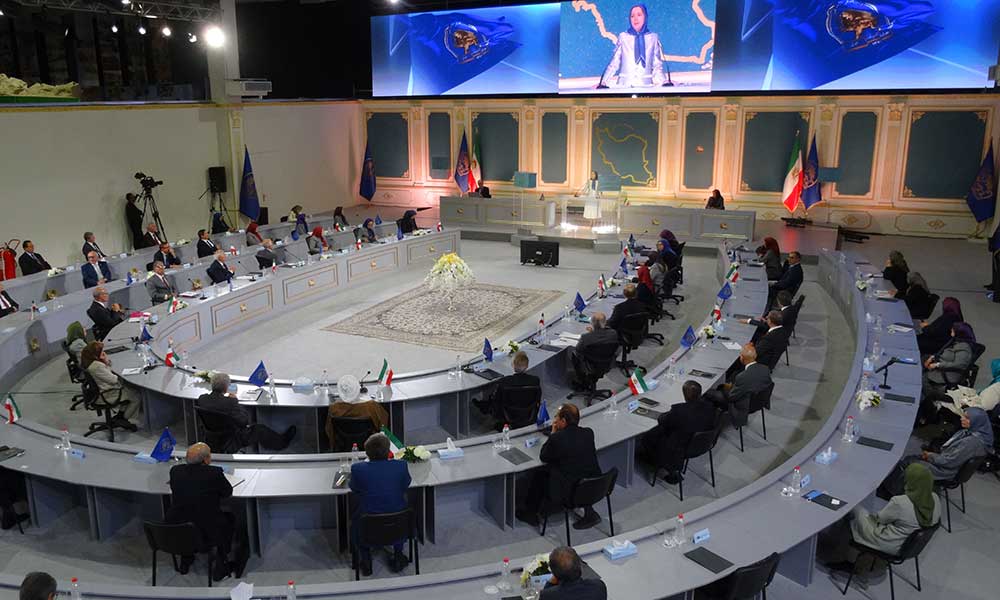
Speech to the three-day session of the National Council of Resistance of Iran on the 40th anniversary of the foundation of the NCRI (July 23-26, 2020)
Honorable members of the National Council of Resistance of Iran (NCRI),
Esteemed friends and personalities who are participating in the third day of the NCRI session as observers,
I welcome you all to this meeting, one of the sessions of this year’s Free Iran Global Summit, and I commend each and every one of you for your efforts for the freedom of our nation and homeland.
Please allow me to congratulate the people of Iran, on your behalf and along with you, on the beginning of the 40th year of the foundation of the National Council of Resistance of Iran. The suffering, torture and struggles of consecutive generations of the Iranian people over 120 years made it possible to establish and sustain a democratic alternative.
The Iranian society, Iran’s history, and the revolutions and movements which have been constantly in the making since the Constitutional Movement, created the potential for instituting such a grassroots alternative to achieve people’s sovereignty. However, it would have been impossible to transform this potential into a political and concrete reality without a qualified leadership and without enormous efforts and suffering. And this has been the role of Massoud Rajavi, the NCRI President, who triumphantly marked such a magnificent accomplishment and through it, guaranteed the future of the Resistance movement in its entirety.
Despite the existing historical conditions for the formation of this democratic alternative, neither was its founding without a price, nor was its preservation and advancement easy or cheap.
As we mark the beginning of the 40th year of the NCRI’s foundation, let us at the outset pay tribute to great martyrs such as Shokrollah Paknejad, who was among the first to encourage the formation of the NCRI. Since April 1981, the Mojahed newspaper, which is the official publication of the People’s Mojahedin Organization of Iran, started publishing columns entitled “The Council.” Mr. Paknejad admired this work and said “The Council” could be an axis for bringing together progressive forces.
Let us also commemorate the great writer Gholam Hossein Sa’edi who wrote for the monthly publication of the NCRI, and renowned artists such as Marzieh, Emad Ram, Andranik, Manouchehr Sakhaii, Bahram Alivandi, Mansour Ghadarkhah, and Mohammad Seyyedi Kashani.
We will not forget NCRI representatives Prof. Kazem Rajavi and Mohammad Hossein Naghdi. And veteran members of the NCRI including Messrs. Yazdan Haj Hamzeh, Samad Sajedian, Hossein Shahidzadeh (Kak Hessam) and my sisters, Batool Rajaii and Zahra Mehrsefat.
We will not forget the honorable NCRI Committee Chairs, Ebrahim Zakeri, Mohammad Ali Jaberzadeh, Giti Giveh Chinian, as well as dozens of NCRI members including Zahra Rajabi, Hossein Abrishamchi and Zohreh Gha’emi, who were killed in terrorist attacks, during massacres or the criminal blockade of Camp Ashraf and Camp Liberty.
I would also like to pay homage to Marjan and Massoumeh Joshaghani both of whom were among the resistant political prisoners in the clerical regime’s dungeons.
We salute them all, who remained loyal and committed to their cause until their last breath. Each and every one of them is a source of pride for our nation and history.
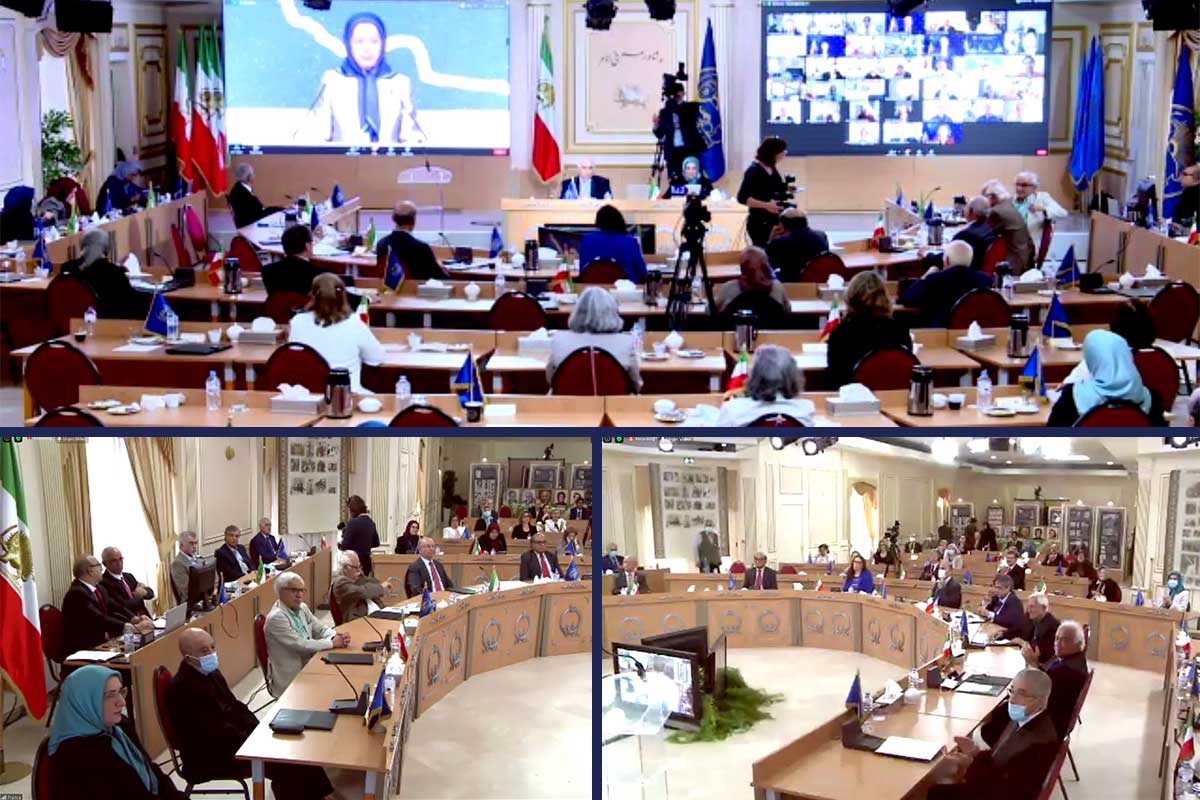
Uprisings could erupt any moment while the regime is in dire conditions
The NCRI’s interim session is being held while, unfortunately, the death toll due to the coronavirus in Iran has reached at least 76,000.
The Iranian Resistance has rightly declared that (the mullahs’ supreme leader, Ali) Khamenei and (the regime’s president, Hassan) Rouhani have adopted the policy of causing mass human casualties to fend off popular uprisings and the threat of being overthrown. They find the coronavirus as a gift and an opportunity, also as an ally and a savior for the regime and against our people.
Now, we hear even one of the regime’s own parliamentary deputies, from Gonbad Kavous, complaining: “It’s as if they have sworn to kill all the people.”
They want to discourage, demoralize and pacify the people, but the Iranian society has shown that it cannot be defeated.
In the case of the death sentences issued on Khamenei’s orders for three protesters of the November 2019 uprising, we saw that millions of people in Iran, and abroad, expressed their outrage and protest. Then, there was the uprising of our compatriots in Behbahan (in Khuzestan Province). These actions demonstrated that our society is prepared to rise up and overthrow the regime, and that they use every opportunity to declare this readiness.
As it has been outlined in its Ten-Point Plan, the Iranian Resistance has been calling for the abolishment of the death penalty for years. We emphasize on this need and we call on our compatriots to widely protest, more than any other time, the implementation of this inhuman punishment against Iran’s youth and those arrested during the uprisings. The regime must free all political prisoners. Once again, we call on international institutions and world governments to pressure and compel the mullahs’ regime to release all political prisoners.
Yes, the mullahs have not been able and will not be able to defeat our people through suppression and terror.
Although they created a bloodbath during the uprising in November 2019, they were not able to extinguish its flames. Behbahan, Mahshahr, Shiraz, Kermanshah, and Shahriar were drenched in blood, but they are waiting in the wings to rebel.
Additionally, the clerical regime has experienced a chain of defeats in recent months.
It failed in its sham parliamentary elections in February. Even the regime’s engineered figures about the election turnout show that it marked the lowest turnout ever during the past 40 years. The regime also failed to prevent the expansion of resistance units, as their operations and activities have continued incessantly despite the wave of arrests and clampdown.
The persistent and tireless struggles of the PMOI/MEK, the selfless risk-taking of the resistance units, and the leadership role of the NCRI President in directing the anti-regime fighting force and the courageous youths in Iran, have all had a brilliant impact on the flourishing of our resistance over the past two years.
Today, what the regime fears most is the eruption of another fiery uprising, spreading across the nation. The horrifying reality for the regime is the fact that their suppressive apparatus is tremendously fragile and lacks backing.
Western appeasement of the regime has been changed to a large extent, and protection and placating of the mullahs have been replaced by terrorist designations and sanctions. Qassem Soleimani’s elimination dealt an irreparable blow to the regime’s terrorism and suppression, tremendously demoralizing the IRGC.
In such circumstances, the regime is continuing its strategy of mass human casualties, sowing the seeds of death and despair in society to fend off protests. In the meantime, it raises the prices of bread, power, petrol and gasoline, time and again picking the pockets of the people. It has also struck treacherous deals with foreign parties. The regime is waiting for the U.S. presidential elections, hoping that the policy of placating the mullahs would be restored. But there is a volcano waiting to erupt in the heart of society. The regime’s situation, with its economic, social and political foundations eroding, has got to a point where nothing can save it.
We should not forget this lesson of history that when the circumstances for the Shah’s overthrow were ripe, he could not stand against the will of the people of Iran despite enjoying extensive support from western governments.
In these circumstances, the Iranian Resistance echoed the firm resolve of the people of Iran by holding the world’s largest online gathering, strengthening their determination against the inhuman mullahs and their ideology of death and destruction. This resistance is a harbinger of perseverance, love of life, progress, and victory in the most difficult circumstances.
Neither the Shah, nor the mullahs
Today, we have a 39-year record since the inception and founding of the National Council of Resistance of Iran. Let us focus on the true role of this alternative in Iranian society and history:
Which fundamental problems have been resolved by the NCRI in the historic struggle between the Iranian people and the theocratic regime? And for the future of Iran after the regime’s overthrow, which foundations and cornerstones have been laid by the NCRI to prevent the country’s return to dictatorship, reactionary ideology and dependence?
Over the past century, two major currents have been evolving in parallel:
The first current has been an appallingly despotic regime founded through the complicity of the monarchic and the clerical regimes despite their drastic natural differences. The second current has been an alternative developing from the heart of the people’s front, for the sovereignty of freedom and a people’s republic. This is the essence of the history of the past 100 years in Iran.
A review of this history yields another conclusion as well:
That the model of monarchy which is also a model of dependence and despotism has failed. The model of religious dictatorship which is a model of religious tyranny has also failed. The dark despotic rule of Reza Khan abandoned Iran into the clutches of the Allies who occupied the country. His son’s dictatorship led to a reactionary religious rule. Khomeini ravaged Iran through an eight-year war and through senseless massacres and genocides. And Khamenei plunged Iran into regional wars, suppression, hunger and disease.
So, both models have failed. And the answer, the solution, is the NCRI, which has emerged on the basis of rejection of foreign dependence and defiance of religious fascism. We all know that the NCRI was founded on the basis of the declaration “no to the Shah and no to the mullahs.” This demarcation is the rejection of regimes which rely on torture, murder, plunder, treachery, and depravation of the people.
In the face of the dictatorships of the Shah and the mullahs, the National Council of Resistance of Iran relies on the principles of freedom and popular sovereignty, which means:
Freedom of choice and vote for all citizens, freedom and democracy, gender equality, autonomy of ethnic groups, human rights, people’s participation in deciding their own destiny, social and economic justice, and national solidarity. Since the outset, all these issues have been areas of conflict between us and the ruling reactionary regime immediately after Khomeini seized power.
Transfer of sovereignty to the people of Iran
During the Constitutional Revolution (at the turn of the 20th century), when people took to the streets, they uttered the words “Iranian nation” for the first time. This sums up everything for the NCRI: people’s sovereignty.
As you know, the members and components of the NCRI have stood up from the onset against the usurpation of people’s sovereignty by Khomeini. Among other things, they did not vote for the Constitution of the clerical dictatorship.
The NCRI is duty-bound to transfer sovereignty to the people of Iran. The NCRI platform recognizes the people’s right to decide their own destiny. It has declared that “achieving popular sovereignty… is the most precious outcome of the Iranian people’s just Resistance.”(1) It further adds that the prerequisite for popular sovereignty is “to provide and guarantee the equipment, resources, and ways of intervention and participation of all the citizens in making decisions and implementing them.”(2)
In fact, the fundamental spirit of the NCRI Platform, the essence of its adopted plans, and the content of its most important statements and declarations are in a word summed up in the principle of the people’s sovereignty in place of the sovereignty of the Shah and the mullahs.
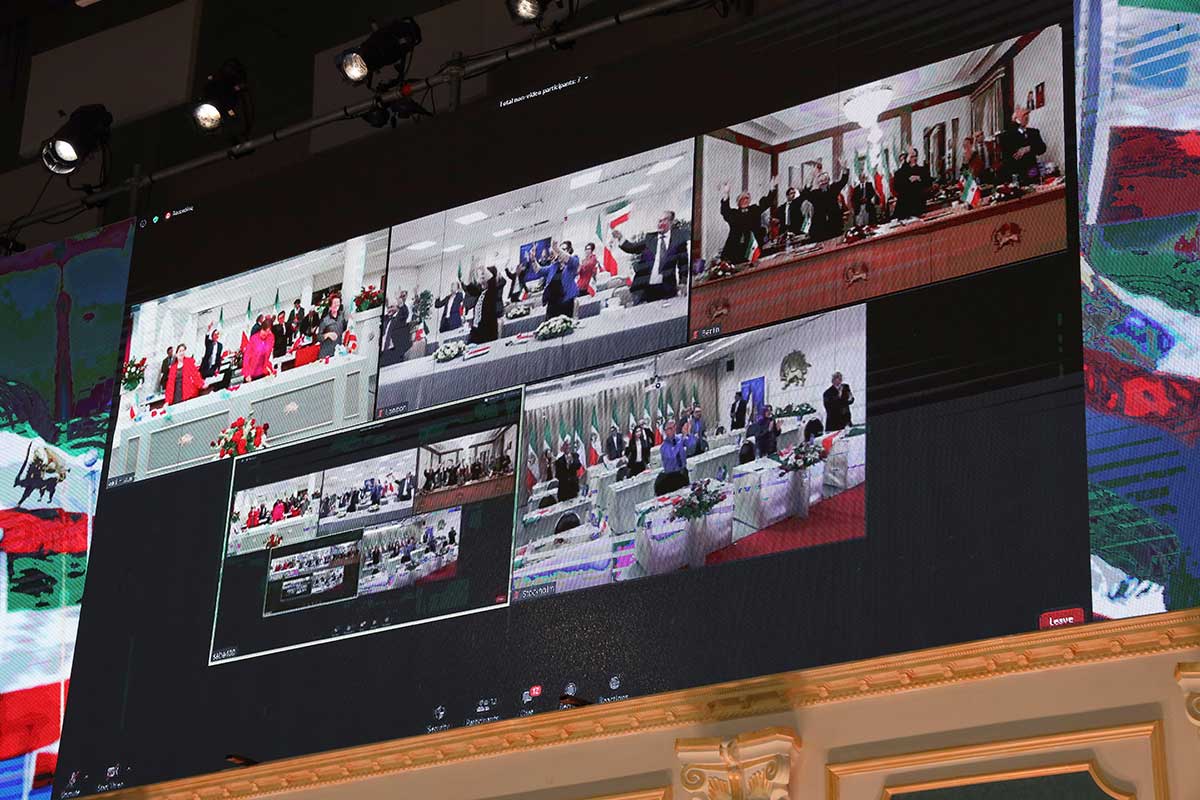
Regime’s lack of capability to reform and the need to overthrow it
In its statements and resolutions since the early 1980s, the NCRI has proven that based on its analysis of the nature of the clerical regime, and based on practical experience, the Velayat-e Faqih regime (i.e. absolute clerical rule) is incapable of reforming itself. It lacks the capability to carry out reforms and to negotiate. It is also incongruent with peace.
In the early 1980s, when some people started speaking of reforms within the regime to justify their relations with it, the NCRI declared:
Any type of illusion about the regime’s capability to change or to reform, is considered complicity with the regime and treason against the highest interests of the people of Iran and their democratic aspirations.
When Khomeini died and (Ali Akbar Hashemi) Rafsanjani began maneuvering about moderation of the regime, the NCRI declared: “This regime will neither become ‘moderate,’ nor will it be able to ‘rebuild’ the country or give up exporting terrorism and fundamentalism.”(3)
After (Mohammad) Khatami took office as regime president, the NCRI again stipulated that “the Velayat-e Faqih regime… does not have the capacity for reforms, opening up, improvement or transformation.” The NCRI added that the fake reformist factions of the regime “only seek to prolong the regime’s rule on the basis of the pivotal role of the Vali-e Faqih.”(4)
Launching the peace movement and the NCRI Peace Plan
One of the greatest contributions of the National Council of Resistance of Iran was to launch the peace movement in the heat of Khomeini’s senseless war with Iraq; a war that left some one million people dead on the Iranian side alone. The ruins caused by that war have not been repaired yet, and the pain and suffering of those who lost their homes have not been relieved.
In March 1982, in the document outlining the Immediate Tasks of the Transitional Government, the NCRI declared that “the urgent termination of the Iran-Iraq war and the establishment of a just peace based on territorial integrity and rights of the people of Iran” are among the Council’s duties.
On May 24, 1982, after the Iraqi forces withdrew from Iran’s territory, and while Khomeini fanned the flames of war, the NCRI President courageously hoisted the flag of peace. With extraordinary risk-taking, he rose up against the ominous war which was deceptively being portrayed by Khomeini as a patriotic and religious duty.
The National Council of Resistance of Iran advanced an extensive peace movement with the motto of peace and freedom. In March 1983, the NCRI adopted its Peace Plan. While emphasizing the 1975 Algerian Accord and the “land and river borders” laid out in that accord, the NCRI underscored that “the determination of war damages will be referred to the International Court of Justice at The Hague” to guarantee Iran’s national interests at the highest level. At the time, the government of Iraq welcomed the NCRI Peace Plan as the basis for the beginning of peace talks. But, 17 years after the fall of the previous Iraqi government, the mullahs’ regime has not been able to sign any peace agreement, even with the governments in Iraq which are under its own influence.
Iran’s national interests
From the Peace Plan to the Peace Movement and a relentless struggle against the regime’s clandestine activities to build nuclear weapons, and revelations of the regime’s treacherous accords, the NCRI has always focused on defending the national interests of the Iranian people.
Since June 1991, when virtually nobody had any information about the regime’s nuclear projects, the NCRI launched its extensive attempts to expose these projects. In the early 2000s, the NCRI divulged documents which revealed the regime’s 18-year clandestine nuclear weapons projects. We took major strides on this path with the motto of a “non-nuclear Iran.”
In its annual statement in 2004, the NCRI declared, “We deemed it as our own humanitarian and patriotic responsibility, in line with our peace-loving stance, to expose the clerical regime’s secret centers built in the cities of Natanz and Arak meant for developing nuclear weapons, and to inform the relevant international authorities in order to prevent a catastrophe.”
National solidarity
Another fundamental issue the NCRI successfully resolved was the creation of a democratic capacity to create a political front and spur cooperation among all those who have waged a struggle for the regime’s overthrow.
In 2002, the National Council of Resistance of Iran ratified the Plan for the National Solidarity Front. The NCRI declared that it was prepared to cooperate with all forces who seek to establish a republic and a democratic, independent political system based on the separation of religion and state, provided that they pledge to reject the mullahs’ religious dictatorship in its entirety, with all its internal factions.
Subsequently in the aftermath of the uprising which started in December 2017, the Iranian Resistance and the NCRI President declared that the NCRI “has constantly called for a National Solidarity Front to overthrow the mullahs’ religious dictatorship, while refusing to adopt a parochial outlook or to merely insist on its own positions, platform and adopted plans.”(5)
Because of the importance of this issue and in order for it to be documented in history, you can see the extent of flexibility and tolerance demonstrated by the National Council of Resistance of Iran to provide the conditions for national solidarity among forces within the people’s front. This is despite the fact that over the past 40 years, the NCRI has been the highest ranking and the most effective opposition force to the mullahs’ religious dictatorship, by leaps and bounds compared to others, making the greatest sacrifice and suffering the most while waging a relentless battle.
I would like to read from the statement of the NCRI President on January 6, 2018:
“The National Council of Resistance of Iran has constantly called for a National Solidarity Front to overthrow the mullahs’ religious dictatorship while refusing to adopt a parochial outlook or to merely insist on its own positions, platform and adopted plans. The NCRI has declared that it is prepared to cooperate with all forces who seek to establish a republic and a democratic, independent political system based on the separation of religion and state, provided that they pledge to reject the mullahs’ religious dictatorship in its entirety, with all its internal factions.”
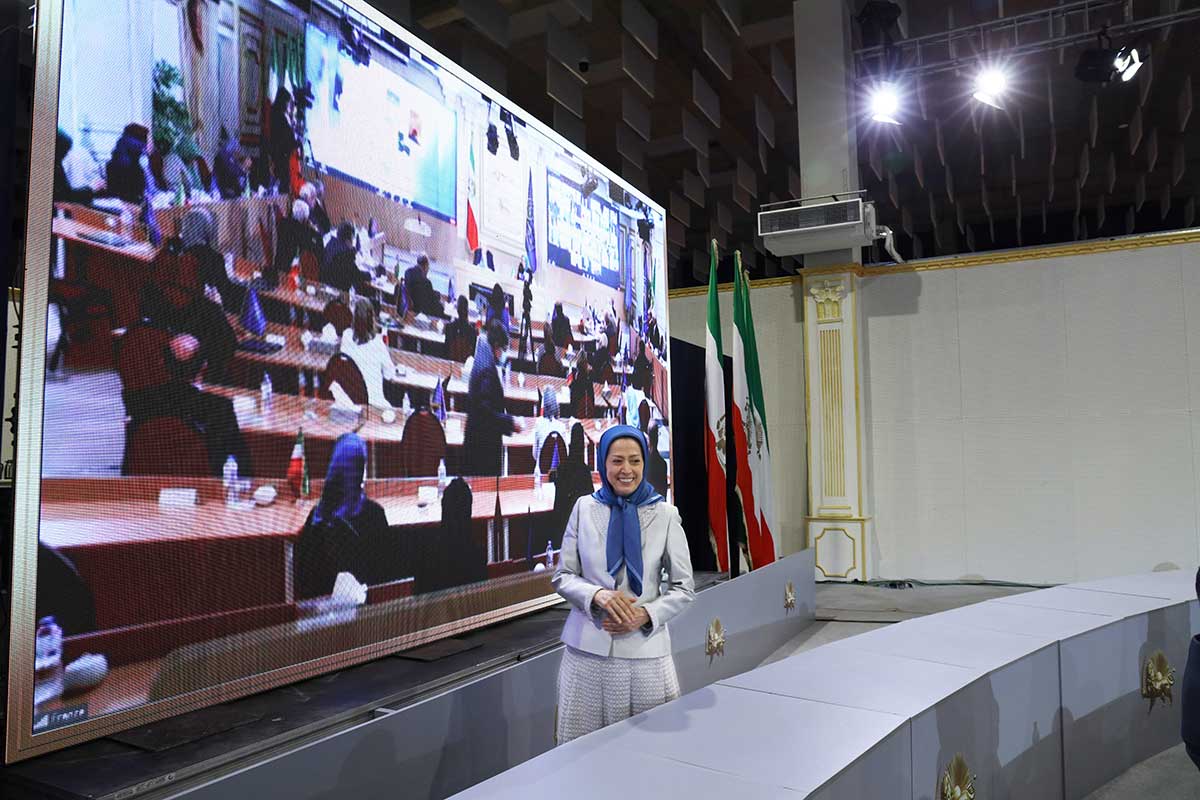
Separation of Religion and State
The NCRI’s response to the experience of religious fascism and barbaric despotism under the banner of Islam is the Plan on Provisional Government’s Relations with Religion, adopted by the NCRI in November 1985.
The NCRI Plan denounces all religious coercions and compelling people into practicing religion. It further rejects all forms of “discriminations as well as any political or social privileges and coercions” in relation to Islam.
The NCRI Platform, drafted in 1981, underscores “equal political and social rights of all citizens” and seeks to abolish “all gender, ethnic and religious privileges.” Of course, the mere formation of the NCRI and the relations among its forces serve as a practical model of separation of religion and state, and a republic based on freedom and equality.
The plan, on the one hand, stipulates that “under no circumstance is any religion or denomination recognized as possessing special privileges or rights”(6) and, on the other, it underlines “the freedom of religions and faiths.”
The plan emphasizes in its first article that “All forms of discrimination against the followers of various religions and faiths in the enjoyment of their individual and social rights are prohibited. No citizens shall enjoy any privileges or be subject to any deprivations in respect of nomination for election, voting, employment, education, becoming a judge, or any other individual or social rights, for the reason of belief or non-belief in a particular religion or faith.” In Article 3, the Plan stipulates that “Jurisdiction of judicial authorities is not based upon their religious or ideological stance, and laws not formulated within the legislative institution of the land will have no official sanction or validity.”
In fact, the NCRI has managed to resolve an issue which dates back to the first Iranian parliament after the Constitutional Revolution in 1906. At the time, during debates over amendments to the Constitution, a major division took place in the parliament between supporters of the Constitution and defenders of the rule of law and democracy on the one hand, and on the other hand, supporters of theocracy and ancestors of the current ruling mullahs such as Sheikh Fazlollah Nouri. Support for a theocratic regime finally led to the despotic rule of the Velayat-e Faqih under the banner of religion, something that the people of Iran have been experiencing for 42 years with their flesh and blood.
In diametric opposition to this theocratic regime, the People’s Mojahedin Organization of Iran (PMOI/MEK), which is a member of the NCRI, represents a tolerant Islam that is the antithesis of Khomeini’s reactionary outlook, and the ignorance and reactionary ideology which are represented by him and the Velayat-e Faqih regime. When the PMOI/MEK movement, harboring such a progressive outlook, endorses the abolishment of all religious-based privileges, it lends a strong and serious backing to the NCRI Plan on the separation of religion and state, and starkly distinguishes it from the customary groundless rhetoric.
Gender equality
The National Council of Resistance of Iran has pursued a persistent and incessant fight against the catastrophic oppression and inequality of women in Iran. It has presented a clear plan since 33 years ago to obliterate gender inequalities. Unanimously adopted, the Plan reiterated the need for Iranian women to attain their rightful place in society. It thus inspired Iranian women to wage a struggle for their freedom and equality. Likewise, women’s place in the NCRI, its member organizations, and the National Liberation Army of Iran opened a new chapter in the status of women in Iranian society. On the other end of the spectrum is a regime which could not even tolerate a staged women’s committee in its parliament and changed it to the Family Committee.
The autonomy of ethnic groups
Another issue the NCRI tackled since its inception is the autonomy of the oppressed ethnic minorities. Of course, since the beginning of Khomeini’s rule, the groups and forces which later made up the National Council of Resistance of Iran stood up against the suppression of our Kurd, Arab, Turkman and other ethnic compatriots by the regime.
The NCRI underlines in its plan that all ethnic groups and all the various nationalities of our country will enjoy internal autonomy. The Plan also underscores that their cultural, social and political rights and freedoms are provided within the framework of the country’s unity, national sovereignty and territorial integrity.
Specifically, the NCRI drew up a 12-point plan for the Autonomy of the Iranian Kurdistan which was adopted in 1983. After three decades, it remains one of the world’s most comprehensive models in this regard.
A model for a democratic Iran
Since the outset, the NCRI President has said, “We wish to present a model based on which we could solve all the problems in a post-Khomeini Iran, in a democratic atmosphere, and in line with our people’s interests.”(7)
The NCRI has pledged not to seek power but to transfer power to the people of Iran. Based on the plans adopted by the National Council of Resistance of Iran, the Transitional Government must hold a free election to form the National Constituent and Legislative Assembly within a maximum period of six months. As far as the Transitional Government is concerned, the task of transferring power to the people will end as soon as the National Constituent and Legislative Assembly is formed.
Among other values and traditions and democratic methods upheld by the NCRI is the rejection of the balance of power principle in its internal relations. Instead, the NCRI respects the rule of “equal vote” and “one vote for every member” regardless of the fact that the member represents an organization as big as the PMOI/MEK, or is an individual.
This method is unprecedented in the history of political coalitions, because every coalition is formed based on the balance of power among its member parties. All decisions and agreements are subsequently made based on the same balance of power. As a result, individual personalities and smaller groups do not play a sufficient role.
And all of you have witnessed over the years, that the NCRI President has never ever made any decisions without the consensus of all member organizations and personalities.
The NCRI relies on debates and persuasion, without any exception, for the adoption of its plans and documents. This bears great significance particularly since we are in exile and away from our homeland, and preserving the coalition, its unity and collective progress is an extremely difficult task.
The platform of the National Council of Resistance of Iran indicates that everyone must pass the test of “public opinion polls and general elections,” and additionally adopt the method of “free public debates and general consensus” as much as possible.(8)
By offering a progressive platform and groundbreaking plans for the future of a free Iran, the National Council of Resistance of Iran has raised the bar and positively contributed to the progressive nature of the resistance movement and of Iranian society.
The credibility of NCRI plans and documents emanate from its commitment to a relentless resistance against the clerical regime. They have had a great impact on inspiring progressive generations in Iran and leading them towards freedom.
This constant struggle also provides the dynamism for the NCRI’s endurance and growth.
As far as I know, the NCRI is the only example in the contemporary political history where the departure, expulsion or treason of its members or their defection to the regime’s camp, have been transparently reported to the people of Iran, one by one, via statements, resolutions, publications and particularly, reports by the NCRI President. Never in the past 40 years, have we been instigators of a dispute with any individual or any group. As the NCRI President has repeatedly announced on various occasions, we have always been the party to terminate a problem, since the sole criterion for us (in dealing with any problem) is our struggle to overthrow the regime.
This has been particularly so with regards to the individuals who trespassed the NCRI’s red lines, seeking rapprochement with the mullahs or those who fell into traps placed by the regime’s Intelligence Ministry and later posed as being critics of the NCRI and the PMOI/MEK. This has also been one of the high points of the NCRI’s history in recent years.
There is an old saying that a blacksmith can be trusted only when the sound of his hammer never stops from morning to night. The Iranian people also trust this movement because they constantly and incessantly hear the sound of the movement’s hammer in the course of its fight.
To protect the sacrifice and suffering of the people of Iran and their most valiant children, and to guarantee Iran’s future, the NCRI President offered and founded this alternative, guaranteeing its endurance during 40 years through numerous trials and tribulations and great suffering.
The steadfast members and loyal supporters of the NCRI have also shown in the past four decades that they are profoundly aware of this mission. They have shown that to protect this independent alternative, they will not cave in to any power or government, and they will not tolerate the slightest distortion of its principles.
They have shown that they pay any price to protect the demarcations and red lines of the people of Iran against the religious dictatorship in its entirety.
They have shown that in every storm, in every test, in every difficulty and under any pressure, they will not abandon their struggle to overthrow the regime. They give their all for the struggle and resistance for freedom.
This is why the camp of the various enemies of the people of Iran led by the mullahs is so infuriated and terrified of hearing the voice of this Resistance. This is why they hear their death knell through the voice of this Resistance. This is why the clerical dictatorship and its hirelings and mercenaries shake to their core when they hear a single word or a gathering of this Resistance.
The NCRI is actually the essence and history of the evolution of 40 years of struggle by the people of Iran filled with many tests and numerous ups and downs. The NCRI is part of Iran’s history and is, in reality, a political umbrella for the people’s struggle to achieve freedom, independence, justice, as well as economic and social progress.
Iran’s future history will pay homage to the special place of the NCRI President and his momentous initiative, as it will be profoundly affected by this democratic alternative and the great contributions it has made to advance the cause of the Iranian people’s freedom and sovereignty.
Since the outset, the National Council of Resistance of Iran has proudly remained steadfast in this historic battle, and it will do so until the day of victory when sovereignty is transferred to the people of Iran.
On the anniversary of the Eternal Light operation, I would like to end my remarks by extending our warmest regards to the Iranian people’s unforgettable martyrs slain during that operation. They rose up and gave their lives to achieve the objectives for which the NCRI was formed. And our Resistance movement remains committed to this mission and will successfully implement its mandate by relying on the people of Iran.
I thank you all.
=========================================
1- Platform of the National Council of Resistance of Iran
2- Preamble of the NCRI Plan for the Autonomy of the Iranian Kurdistan
3- The NCRI annual declaration, July 21, 1992
4- NCRI statement, April 14, 1999
5- The statement of the Secretariat of the National Council of Resistance of Iran, January 6, 2018
6- The NCRI Plan on the Relations of the Transitional Government of the Democratic Islamic Republic of Iran with Faith and Religion, November 12, 1985
7- Remarks by President of the National Council of Resistance of Iran during adoption of the Plan on Women’s Rights and Freedoms on April 24, 1987
8- Platform of the National Council of Resistance of Iran, Chapter 3, Article 4
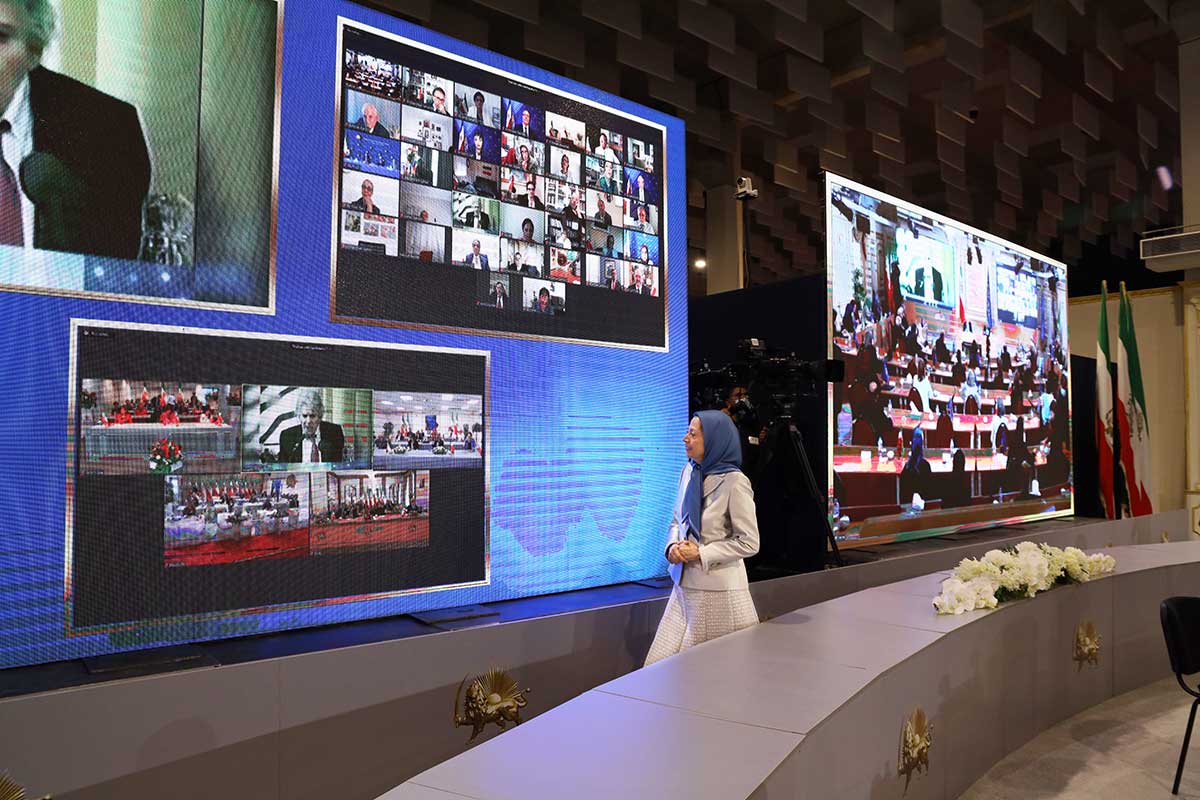
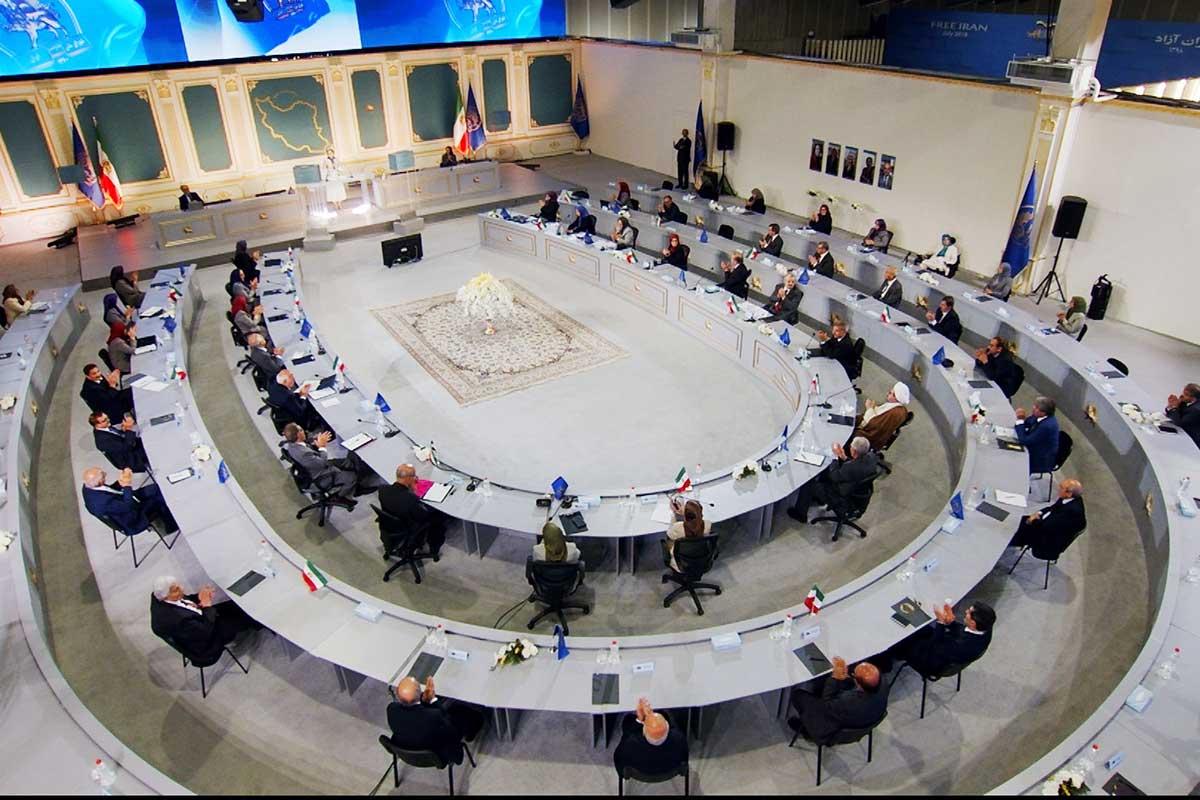
- https://www.maryam-rajavi.com/en/item/maryam-rajavi-iranian-resistance-regime-change-sovereignty-freedom-justice-global-summit
- https://www.maryam-rajavi.com/en/item/maryam-rajavi-seeking-justice-martyrs-holding-iranian-regime-accountable
- https://www.maryam-rajavi.com/en/item/maryam-rajavi-global-summit-iran-regime-terrorism
- Tags: Free Iran, Iran protests, NCRI, Women

